Michigan vegetable crop report – May 31, 2023
Insects and wildlife are attracted to growing plants in dry weather. Continued irrigation is a must.
Weather
Watch Jeff Andresen’s weather update.
The week ending Monday, May 29, saw near-normal temperatures but zero precipitation in the Lower Peninsula. May typically sees 3.5 inches of rain—one of our wetter months—but besides some now in the Upper Peninsula, we’ve had less than 1 inch. Overall, we now have very dry topsoils with moisture at depth, courtesy of a wet March/April and bone-dry May. This means deep-rooted plants have moisture to access, but newly planted vegetables will face dry soil.
The forecast calls for:
- Mostly sunny, windy and much cooler Wednesday, May 31. Clear and cold overnight Wednesday with frost and freezing temperatures possible interior north areas Thursday morning.
- Precipitation is expected to total from 0-0.25 inches at most through June 7, better chances to the northwest.
The four horsemen of hot, dry weather
With the hot and dry weather, it’s worth reading up on the three bugs that seem to thrive in these conditions: thrips, mites and aphids. It also seems like vertebrate wildlife are also keying into our new juicy plants and irrigation systems with this dry heat. Coyotes and ground squirrels are chewing on irrigation lines while deer, groundhogs and birds nibble plants and seedlings. Fencing and netting are effective exclusion methods for some of these pests.
Fencing and netting for wildlife can take many forms with widely varying costs, but the most effective fences are installed before browsing occurs and before animals decide that they enjoy your crop. The largest fence you can afford to spend time or money on will be more cost effective. Some growers appreciate the flexibility of smaller, easy-up and take-down materials for quick crops. Factors to consider are height, depth, density of wire or mesh, electrification, and access for crop management and harvest. This dry weather can affect the power of ground-stake electric fencing. This Michigan State University Extension article outlines considerations for selecting and installing an electric fence charger, and provides tips for this, including placing ground stakes where soil is most shaded, or lowest in the field, and alternative wirings.
This week’s Field Crops Virtual Breakfast is all about wildlife management.
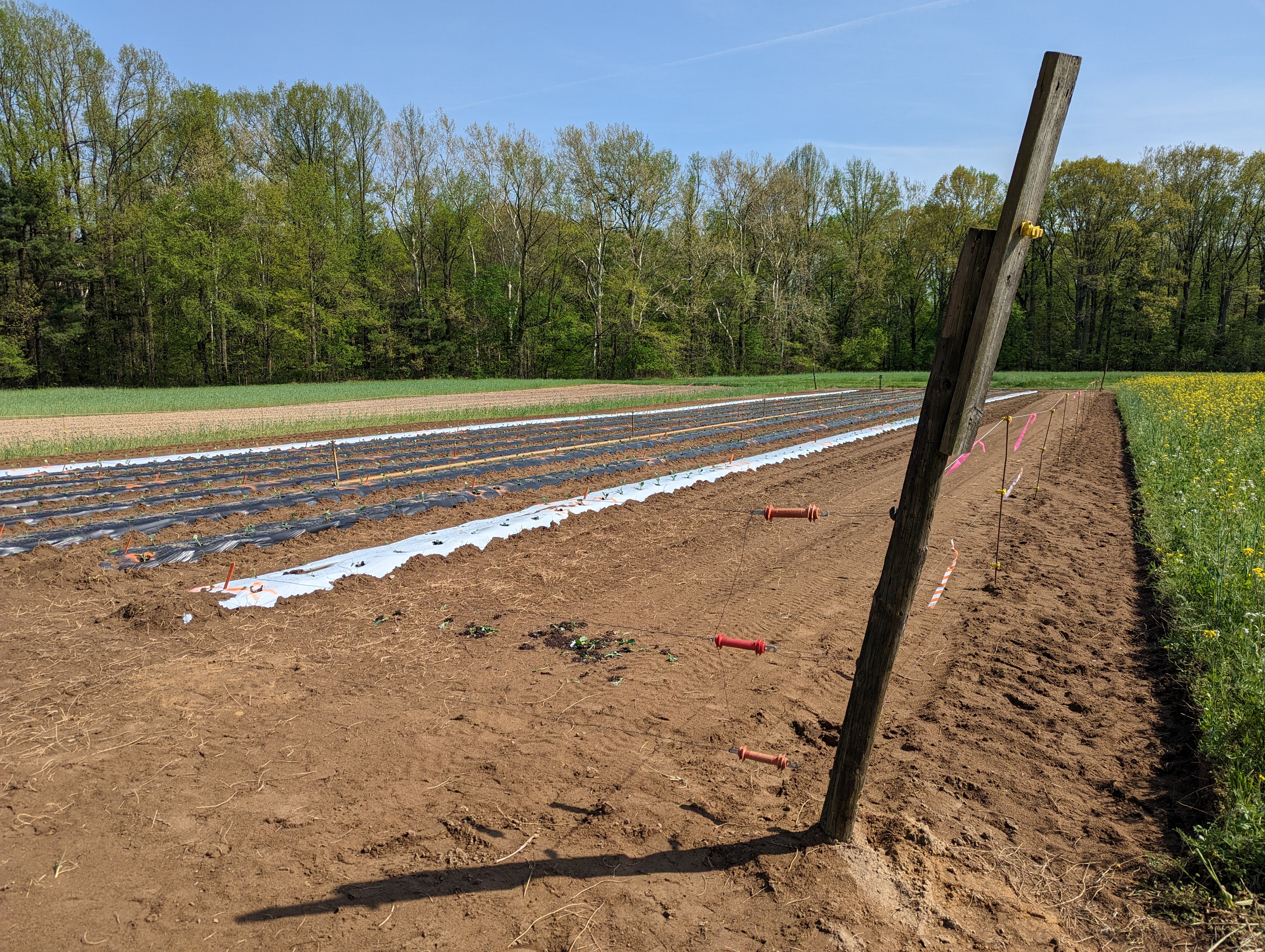
Preemergence herbicides and soil moisture
Preemergence herbicides play a very important role for production of any vegetable crops. Note that the activation of preemergence herbicide depends mainly on soil moisture and there isn’t a significant chance of rain in the forecast. It is important to have at least a half-inch of rain to activate the herbicide in order to move the product to the depth where germinating seeds are located. Here is a great article from Iowa State University Extension that explains the importance of soil moisture after application of preemergence herbicides. The rule of thumb is that if a field fails to receive an activating rain, consider applying irrigation within five to seven days of herbicide application.
Weed of the Week
Common ragweed (Ambrosia artemisiifolia) is an early-emerging summer annual weed found throughout Michigan. It is easy to identify even as a seedling by its lobed, dissected leaves that superficially resemble the shape of carrot leaves. Common ragweed is easily distinguished from its relative, giant ragweed, by its rounded leaf margins as opposed to the latter’s pointed leaves.
Due to its early appearance in the spring, delayed planting can allow for most emerged ragweed to be controlled through shallow tillage or flaming prior to putting in the crop. Standard cultivation tools like spyder wheels, basket weeders, sweeps (between-row) and finger weeders and flextine weeders (in-row) can be used throughout the season. Check out the SARE guide “Steel in the Field” for a breakdown on the different cultivation tools and techniques.
There are numerous herbicides with proven efficacy on common ragweed. Preemergent products include Callisto (mesotrione), Command (clomazone), Karmex (diuron), Shieldex (tolpyralate) and more. Post-emergent options include Basagran (bentazon), Chateau (flumioxazin), 2,4-D, Lorox (linuron), Moxy (bromoxynil), Starane Ultra (fluroxypyr), Stinger (clopyralid) and more. Products with both preemergence and post-emergence activity on common ragweed include Aatrex (atrazine), Caparol (prometryn), Goaltender (oxyfluorfen), Pursuit (imazethapyr), Reflex (fomesafen), Sandea (halosulfuron), Sinbar (terbacil) and Tricor (metribuzin). Check product labels to see what specific vegetable crops these herbicides can be used on.
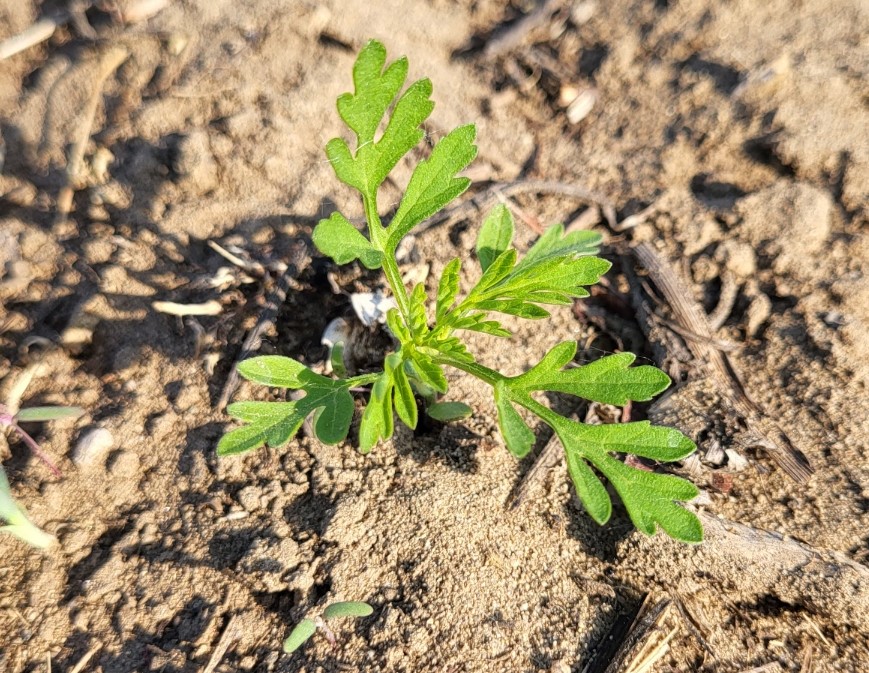
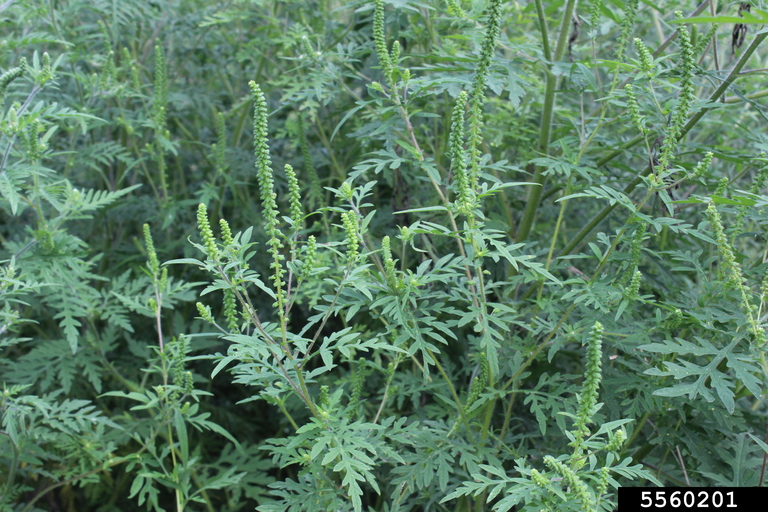
Common ragweed populations scattered across Michigan have developed resistance to chemicals like glyphosate and herbicides from the group 2 (ALS inhibitors) and group 14 (PPO inhibitors) modes of action. In 2018, the first ever population of common ragweed resistant to a group 4 (synthetic auxin) herbicide was found in Michigan. The spread of herbicide resistance is a grim reality and is especially problematic in vegetables where there are few effective products to begin with. This problem can be prevented and delayed by adopting sound resistance management practices, such as rotating herbicide mode of action groups, using recommended rates and adjuvants, eliminating weed escapes, and diversifying your weed control program with mechanical or cultural practices.
If you think you are noticing resistance in your field, you can submit weed seed samples to the MSU Plant & Pest Diagnostic lab to have them screened for herbicide resistance (see this MSU Extension article for more details).
2023 MSU Extension Southeast Michigan Farmer Survey
MSU Extension is pleased to announce our 2023 Southeast Michigan Farmer Needs Assessment Survey. This survey will gather information about your farm and your potential interest in learning more about various farm-related topics. The information gathered will inform future programs and educational opportunities offered by MSU Extension educators for agricultural producers in southeast Michigan. This survey will take approximately 10 minutes to complete and is accessible at the link below:
Take the 2023 MSU Extension Southeast Michigan Farmer Needs Assessment Survey!
Feel free to share the survey link with other growers. We welcome any participation in the survey in order to help Michigan State University Extension better serve its communities.
Crop updates
Asparagus
Hotter, dry weather is the name of the game right now. Here’s a repeat from last week. The abnormally dry conditions for this time of year paired with temperatures in the 80s suggest growers with irrigation should consider using it. Previous and ongoing MSU research on sandy soils has shown that overhead irrigation during hot and dry conditions of harvest can slow spear growth, helping harvest crews keep pace and improving spear tip quality. Given the dry spring and lack of rain, growers should also consider “watering up” as needed to ensure adequate moisture prior to fern growth. Maintaining adequate moisture throughout the summer will improve fern productivity and carbohydrate storage in roots, which has been demonstrated to increase yields of Millennium in Michigan.
Common asparagus beetle was active in known hotspots again this week. Carbaryl not doing the trick? The neonicotinoid Assail (active ingredient acetamiprid) also has a one-day preharvest interval (PHI) and is a different mode of action. Lannate also has a one-day PHI but is a carbamate like carbaryl. Keep in mind that a variety of things affect how many bugs an insecticide application kills: treated spears are harvested, beetles may/may not be active during the application, etc.
Want to store asparagus for later? Here are some lessons from experience and recent research:
- Store the pick of the picks: High quality asparagus with tight tips, etc., will last longer in storage.
- Early harvests may store better than later ones.
- Cut spears may store better than snapped ones.
- Asparagus that is promptly hydrocooled will last longer.
- Controlled atmosphere (CA) storage (11% O2, 10% CO2) may extend shelf life by about a week, but of course there is risk with a new practice like this.
Carrots/celery
The aster leafhopper “sweepstakes” is starting in celery and carrots. The Szendrei lab at MSU partners with consultants and Michigan State University Extension to sweep fields for aster leafhoppers each week, take them to the lab, and test them for aster yellows. Results are texted to growers. Please email Zsofia Szendrei at szendrei@msu.edu if you’d like to sign up for text alerts. An Oceana County leafhopper sample collected Monday, May 22, had 0% infectivity.
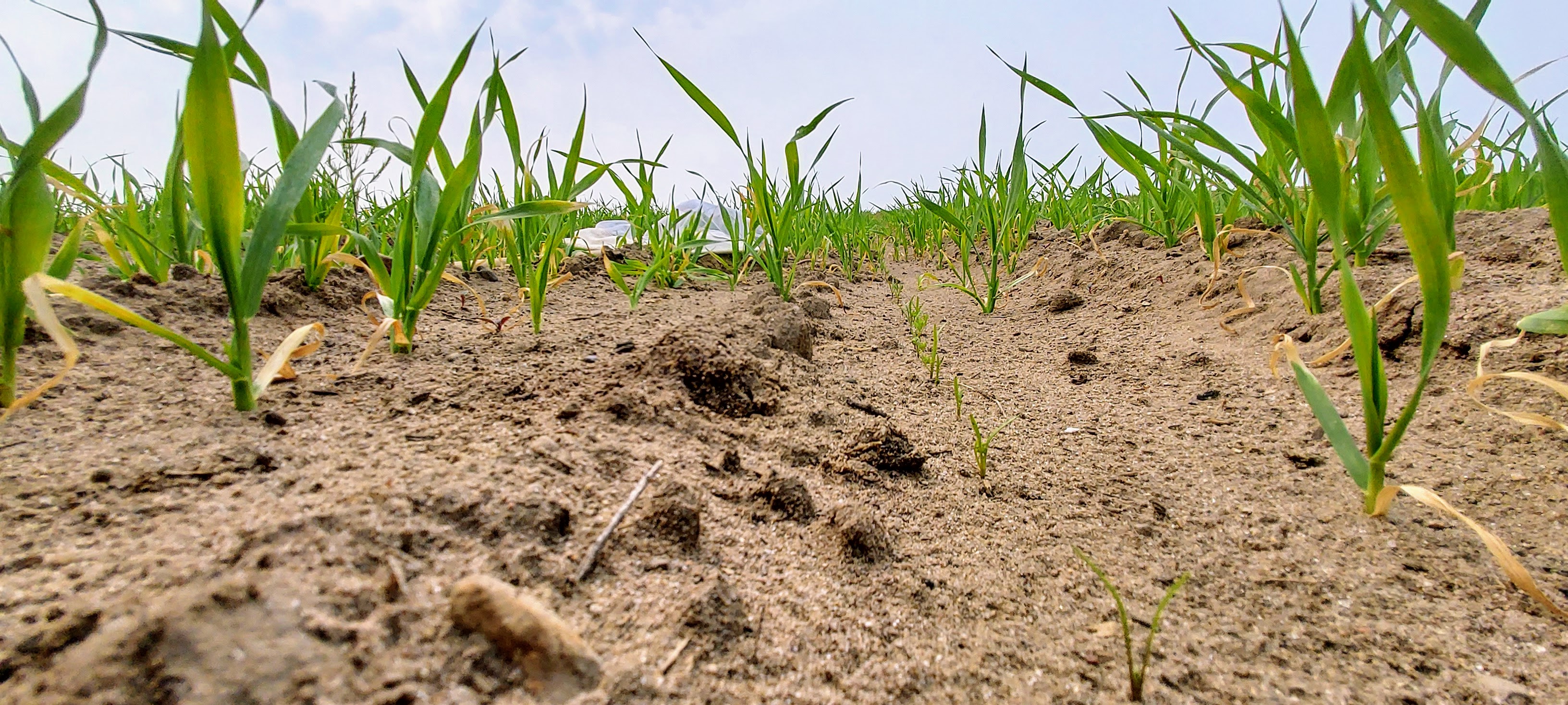
Irrigation is the name of the game for celery growers with the dry weather. Aster leafhoppers are present in some west central Michigan fields, but scouts report numbers are not high. The first infectivity texts from celery should come out this week.
Cole crops and leafy greens
Cabbage and other brassicas and freeze-tolerant leafy greens have been planted since the beginning of April in the southern-tier counties of Michigan. Hoophouse produced greens, including spinach, lettuce and chard have been going to market in some scenarios.
Diamondback moths and imported cabbage worm caterpillars (also known as cabbage white butterflies), flea beetles, aphids, thrips and leafminers can be found in crops right now. Bt can be effective when caterpillars are small and conserves beneficials that help control other pests. Read more about using Bt. Both aphids and thrips can be managed with Movento, Radiant or Exirel, which have a lower impact on beneficial insects than other broad-spectrum insecticides. If aphids are the only problem, mouth paralyzers like Beleaf, Fulfill and Sefina are a good choice to protect other insects. For thrips alone, Entrust is an organic option for suppression. Pyganic and other conventional pyrethroids can cause flare ups or resurging populations of aphids and thrips by killing off beneficial insects.

Leafminers in chard and beets are particularly difficult to manage organically, and are best held in check with good weed control (lambsquarters and pigweeds are also hosts), rotation to keep populations down, and row covers to keep flies out before they get in. Conventional growers can use systemic insecticides to kill larvae as they emerge from eggs and begin burrowing into leaves. Beet tops may need to be chopped instead of bunched if infestations get bad.

Degree days suggest the spring flight of cabbage maggot flies is coming to an end. It is a good time to check fields to see if treatments worked and to assess issues; maggots should still be active. Don’t forget to check out the new, online cabbage maggot predictor tool! It’s revamped to make it easier to digest at a glance where things stand. Eggs and maggots continued to be present at some west Michigan sites Tuesday, May 30.
Cucurbits/pickles
Cucurbit planting continues at a high rate across lower Michigan.
Weed control and crop safety are always questions with cucurbits. Check out this table by Sushila Chaudhari, which lists the options, their strengths and key notes. Also, check out this helpful article on weed control from Minnesota.
Striped cucumber beetle often celebrates Memorial Day with a “spring rush,” as overwintering beetles wake up and colonize cucurbits. Conventional cucurbits can be protected with a neonicotinoid insecticide either through the FarMore FI400 seed treatment, which contains thiamethoxam, or soil applications of a product like Admire Pro (imidacloprid). Imidacloprid (Admire Pro and generics) is helpful when seed does not come pre-treated with FarMore FI400, which can be the case with specialty varieties. It can be applied at planting time in the furrow, chemigated with drip irrigation or as a post-plant drench. If you can’t use a neonicotinoid, now can also be a good time to use a broad-spectrum insecticide like carbaryl, as open field plantings are small and not flowering (i.e., no bees).
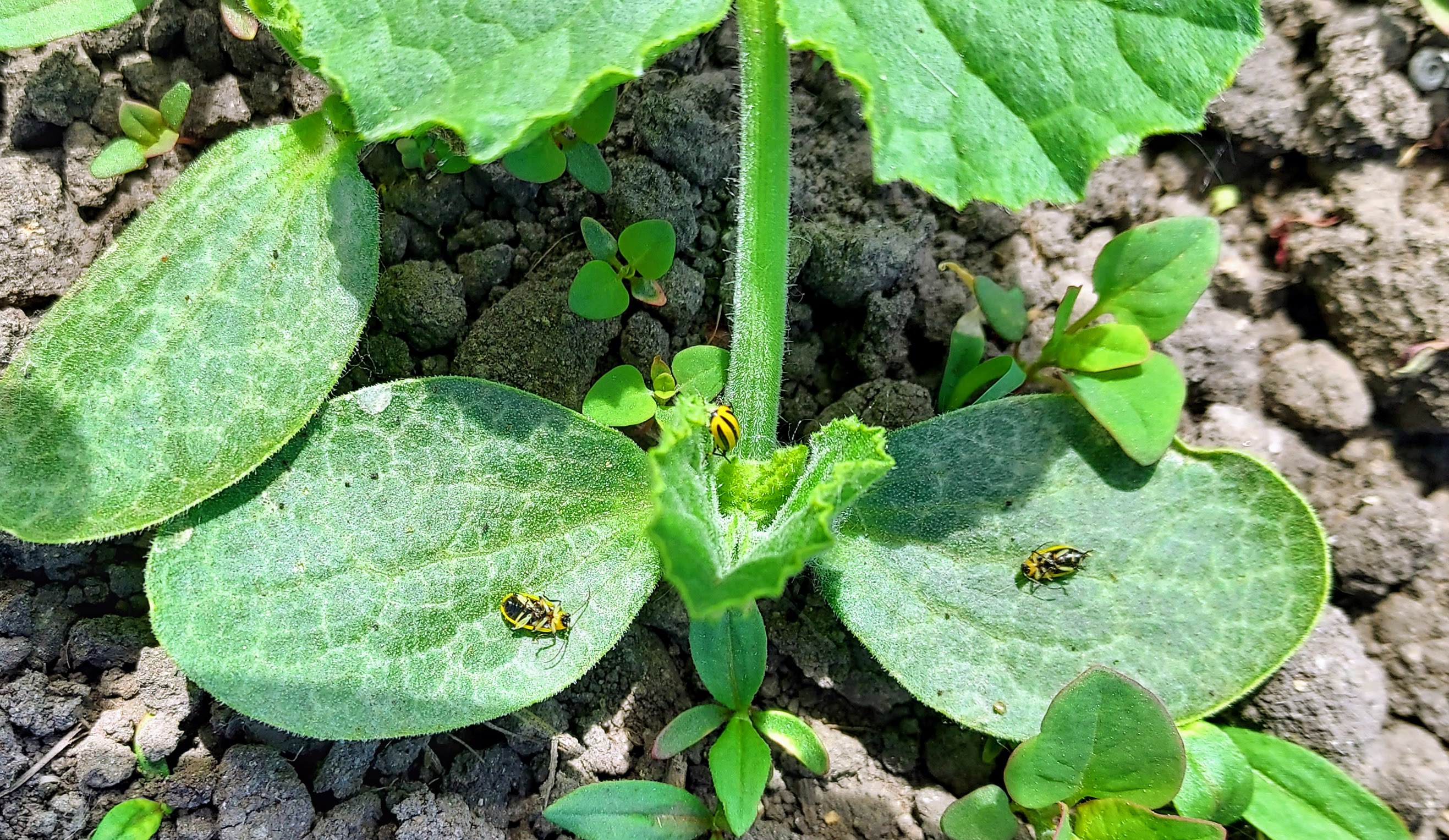
Young cucurbits are most vulnerable to defoliation by cucumber beetle as well as the disease bacterial wilt. Infection happens when beetles feed on young plants and defecate in feeding wounds, which allows the pathogenic bacteria to enter the plant.

Cucumbers and muskmelons are most susceptible to bacterial wilt. Winter squash, pumpkin and zucchini are intermediate, and watermelon is not bothered. Plants gain tolerance with age, so major issues are often the result of early, uncontrolled beetle populations. Short version: Check field edges for this pest if you’ve had issues before.
Fruiting vegetables
Fresh market tomatoes are being staked in southeast Michigan. Transplanting of tomatoes and peppers into plastic mulch is ongoing. Non-chemical weed control between rows in plasticulture systems can be achieved through regular cultivation or planting living mulches. For chemical control, preemergent and post-emergent herbicide options are outlined in the articles ”Recommendations for Under Plastic Mulch Weed Control” and “Weed Management in Tomatoes, Peppers and Eggplant” from Rutgers University.
Transplanting on hot black plastic is a tough condition for plants to grow through. Their stems can girdle from the heat. The most common method to reduce these stressors is to water transplants really well in the trays and get the beds fully wetted before planting so that some evaporative cooling occurs through the holes and plants have plenty of moisture to replenish what they are respiring. Then, center the plants as best as possible so that they are not touching or laying on the plastic. Leggy tomatoes can make this tough! Some growers combine this with temporary overhead irrigation. Others will try to back-fill the holes to create a seal around the plants, but be aware that some between-row herbicide treatments can potentially damage plants. One further technique is to spray kaolin clay (Surround) onto the beds to create a temporary white surface to reflect more sun.
Onions
Onions got a slow start due to cold weather; now things are slow going because of the dry weather. Does it make sense to start Stemphylium programs with the dry weather if onions are big enough? The short answer: Spray programs should be initiated by the five- to seven-leaf stage, regardless of the weather.
Spots and blights on the leaves can get in the way of good onion growth. In Michigan and other eastern production regions, producers wage a yearly battle to protect onions from various foliar diseases. Purple blotch used to be a common disease of onion leaves in the northeast U.S., but Stemphylium leaf blight has now become the most formidable opponent for many onion producers. Stemphylium leaf blight is caused by a fungal pathogen of the same name (Stemphylium vesicarium).
Early symptoms of Stemphylium leaf blight can be difficult to diagnose. Tip burn may be associated with herbicide damage but can also be a first symptom of disease. The brown spots of Stemphylium leaf blight are small at first but increase in size, extending down the leaf. These elongated lesions can appear similar to symptoms of bacterial stalk and leaf blight. An accurate diagnosis can be obtained by sending plant samples with symptoms to a university diagnostic lab. In healthy onions, the oldest onion leaves die first. However, premature leaf death resulting in a mid-season loss of green leaf tissue is typical of Stemphylium leaf blight. Without healthy foliage, bulb size is reduced and so is total yield.
Many of the fungicides that were historically used to manage purple blotch do not adequately protect against Stemphylium leaf blight. Field research from Michigan State University has shown that the Stemphylium leaf blight pathogen is resistant to fungicides classified as strobilurins such as azoxystrobin, picoxystrobin, pyraclostrobin and trifloxystrobin. On the other hand, Omega SC, Luna Tranquility SC, Miravis Prime SC, Tilt SL and Luna Experience SC effectively limit Stemphylium leaf blight. Our research has also shown that fungicide programs to protect the onion’s foliage from Stemphylium leaf blight should begin when plant are young (by the five- to seven-leaf stage) and include highly effective products at the front end of the season to prevent the pathogen from becoming too well established. Once Stemphylium leaf blight is well established, it becomes especially difficult to limit disease progression. Protecting the onion leaves early in the season helps to ensure that the plants have a fighting chance to reach maturity and achieve their full yield potential.
Choosing an effective fungicide program is critical and in combination with initiating the spray in a timely manner as described above, can ensure successful management of an otherwise highly destructive pathogen Field research from Michigan State University tested two fungicide programs with sprays applied every seven days (Table 1). Each program effectively limited disease but Program #2 is less reliant on fungicides that have a similar mode of action.
|
Table 1. Two fungicide programs applied at seven-day intervals for Stemphylium leaf blight control by MSU in field trials. |
|||
|---|---|---|---|
|
Program 1 |
Program 2 |
||
|
App#. Product |
FRAC |
App#. Product |
FRAC |
|
1. Luna Tranquility |
7/9 |
1. Bravo WS |
M05 |
|
2. Tilt SC + Bravo WS |
3/M05 |
2. Tilt SC |
3 |
|
3. Omega 500F |
29 |
3. Luna Tranquility |
7/9 |
|
4. Luna Tranquility |
7/9 |
4. Bravo WS |
M05 |
|
5. Tilt SC + Bravo WS |
|
5. Tilt SC |
3 |
|
6. Miravis Prime |
7/12 |
6. Miravis Prime |
7/12 |
|
7. Omega 500F |
29 |
7. Bravo WS |
M05 |
|
8. Aprovia Top |
7 |
8. Bravo WS |
M05 |
|
9. Miravis Prime |
7/12 |
9. Luna Tranquility |
7/9 |
|
10. Luna Tranqulity |
7/9 |
10. Bravo WS |
M05 |
The Stemphylium leaf blight pathogen is considered high risk to develop resistance to some of the active ingredients in commonly used fungicide products. It is essential to rotate among fungicides with different FRAC codes. Also, it is important to avoid high disease pressure as this exposes a greater portion of the pathogen population to the fungicides and increases the likelihood for resistance to develop. The table below (Table 2) can be used as a guide for producers putting together their programs.
|
Table 2. Fungicides labeled for use on onion included in MSU field studies. |
|||
|---|---|---|---|
|
Product |
Active ingredient |
FRAC |
Number of applications allowed by the label |
|
Tilt |
propiconazole |
3 |
2 to 4 (solo); 4 to 8 (in tank mixes) |
|
Aprovia Top |
difenoconazole/benzovindiflupyr |
3/7 |
4 |
|
Luna Tranquility |
fluopyram/pyrimethanil |
7/9 |
2 to 3 |
|
Miravis Prime |
pydiflumetofen/fludioxonil |
7/12 |
3 |
|
Omega SC |
fluazinam |
29 |
3 to 6 |
|
Bravo WS |
chlorothalonil |
M05 |
6 |
*The FRAC code is an alphanumeric code assigned by the Fungicide Resistance Action Committee and is based on the mode of action of the active ingredient.
** The number of applications allowed by the label may vary depending on the rate applied. Remember that the pesticide label is the legal document on pesticide use. Read the label and follow all instructions closely.
When to spray Movento for onion thrips? It is a balancing act. On one hand, Movento is most effective on immature onion thrips and its systemic action best carries it to the new growth prior to bulbing. This means it is important to not wait too long. On the other hand, applying it too early can mean extra applications of other products; it means the “momentum of Movento” won’t carry control that far into the season. Brian Nault of Cornell University shared some research on Movento “thrips tips” at the 2022 Great Lakes Fruit, Vegetable and Farm Markets Expo:
- Use a penetrating surfactant.
- Two applications are better than one.
- Waiting until thrips reach populations of one per leaf gives control equivalent to a lower threshold of 0.1 per leaf.
One more thrips tip: Exirel provided control equal to or better than Radiant in one New York trial and was recommended as a replacement for the Radiant slot if Radiant is not pulling its weight like it used to. In an ideal world, scouting and thresholds can be used to time sprays. Keep an eye out for 2023 onion thrips guidelines from Cornell University, which should be available soon.
Sweet corn
Succession plantings continue. Sweet corn is progressing well through the vegetative stages where there is adequate irrigation.
Strawberries
Early sites where strawberries are being grown on plastic mulch are being harvested. Matted row crops are sizing berries.
Events
- June 1, 7–8 a.m., Field Crops Virtual Breakfast: Wildlife Management
- June 5, 5:30-7 p.m., Monday Night Southwest Michigan Fruit IPM Meeting
- June 8, 7–8 a.m., Field Crops Virtual Breakfast: Q & A "Hot Topics"
- June 12, 5:30-7 p.m., Monday Night Southwest Michigan Fruit IPM Meeting
- June 15, 7–8 a.m., Field Crops Virtual Breakfast: White Mold Management In Soybean
- June 19, 5:30-7 p.m., Monday Night Southwest Michigan Fruit IPM Meeting
- June 26, 5:30-7 p.m., Monday Night Southwest Michigan Fruit IPM Meeting
- June 28, 9:30 a.m.-3 p.m., MSU Weed Tour 2023
- June 29, 7–8 a.m., Field Crops Virtual Breakfast: Cercospora Leaf Spot Management In Sugar Beets
- July 6, 7–8 a.m., Field Crops Virtual Breakfast: Strategies For Efficient Irrigation Water Use
- July 13, 7–8 a.m., Field Crops Virtual Breakfast: Cover Crops After Wheat
- July 20, 7–8 a.m., Field Crops Virtual Breakfast: Tar Spot
- July 20, 9 a.m. - 1:30 p.m., In-Field and Edge-of-Field Conservation Practice Field Day
- July 27, 7–8 a.m., Field Crops Virtual Breakfast: Bugs And More Bugs!
- August 3, 7–8 a.m., Field Crops Virtual Breakfast: Farm & Truck Vehicle Regulations And Safety
- August 10, 7–8 a.m., Field Crops Virtual Breakfast: How To Get The Best Out Of Your Drainage System
- August 17, 7–8 a.m., Field Crops Virtual Breakfast: "Hot Topic" Q & A Session
- August 24, 7–8 a.m., Field Crops Virtual Breakfast: Timing The Last Irrigation Application
- August 31, 7–8 a.m., Field Crops Virtual Breakfast: Setting The Stage For Record Breaking Wheat Yields
- September 7, 7–8 a.m., Field Crops Virtual Breakfast: Marketing Your Grain Crops
- September 14, 7–8 a.m., Field Crops Virtual Breakfast: Monitoring Nematode Resistance In Soybeans
- September 21, 7–8 a.m., Field Crops Virtual Breakfast: Fall Weed Control
This work is supported by the Crop Protection and Pest Management Program [grant no 2021-70006-35450] from the USDA National Institute of Food and Agriculture. Any opinions, findings, conclusions, or recommendations expressed in this publication are those of the author(s) and do not necessarily reflect the view of the U.S. Department of Agriculture.



 Print
Print Email
Email

